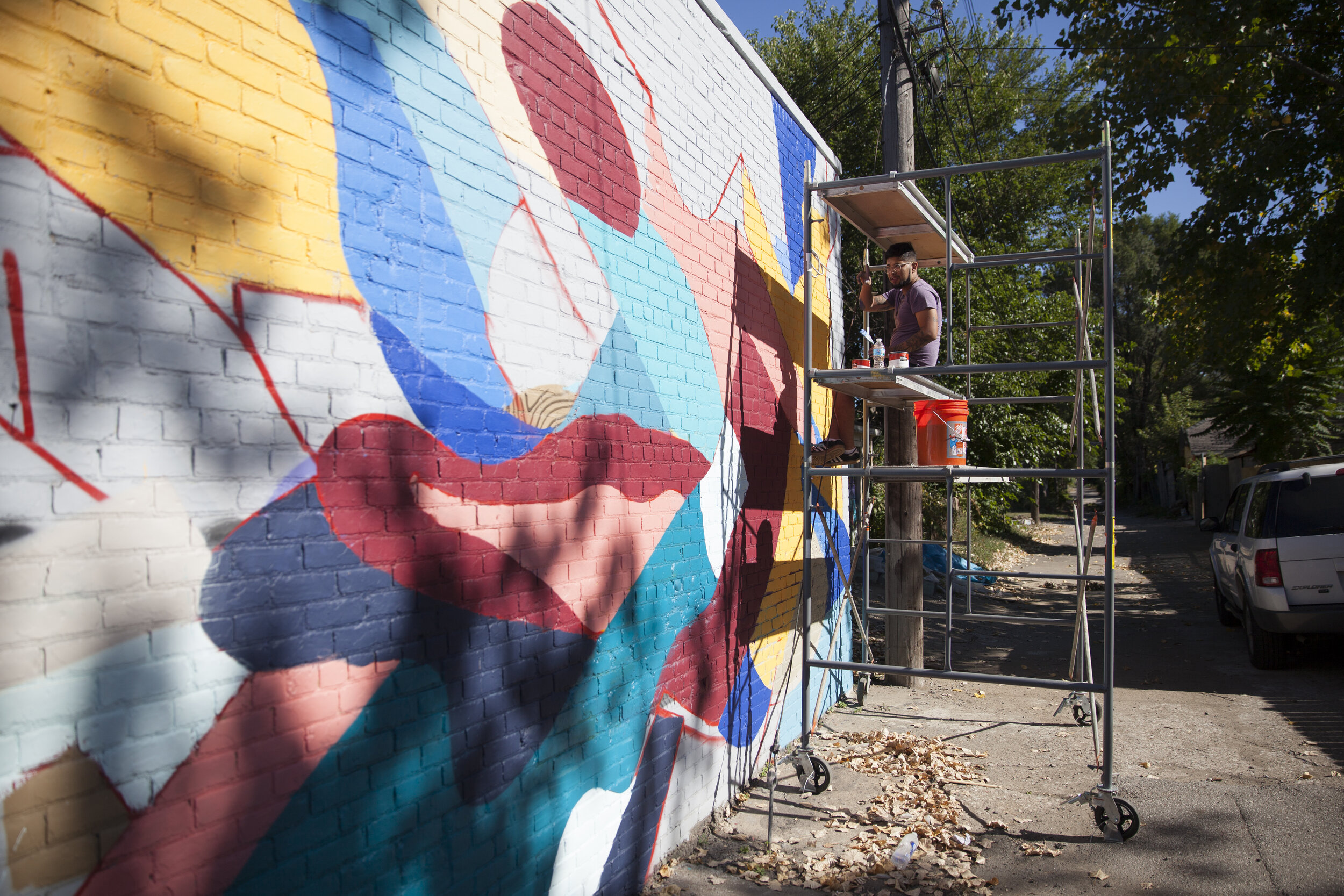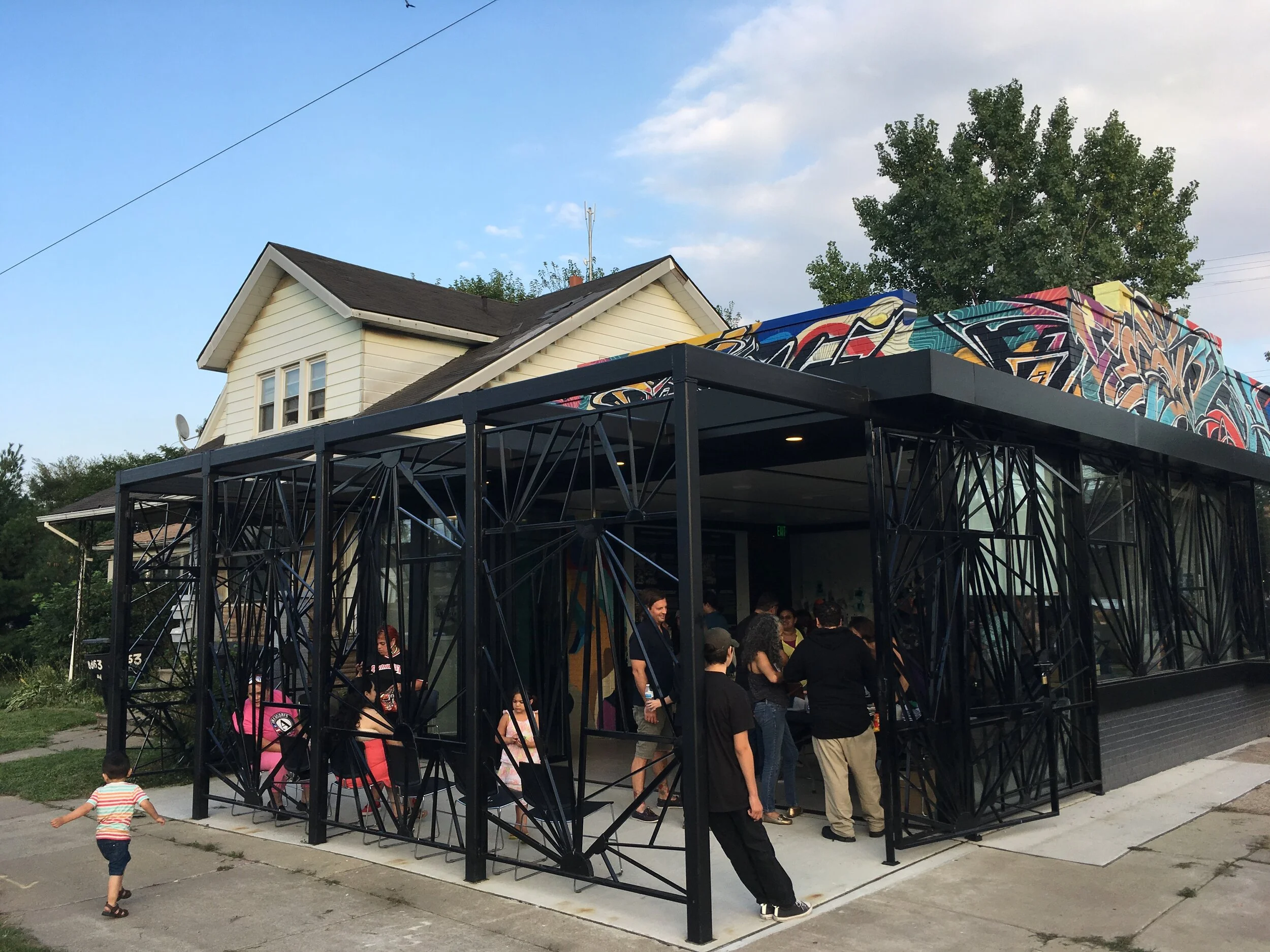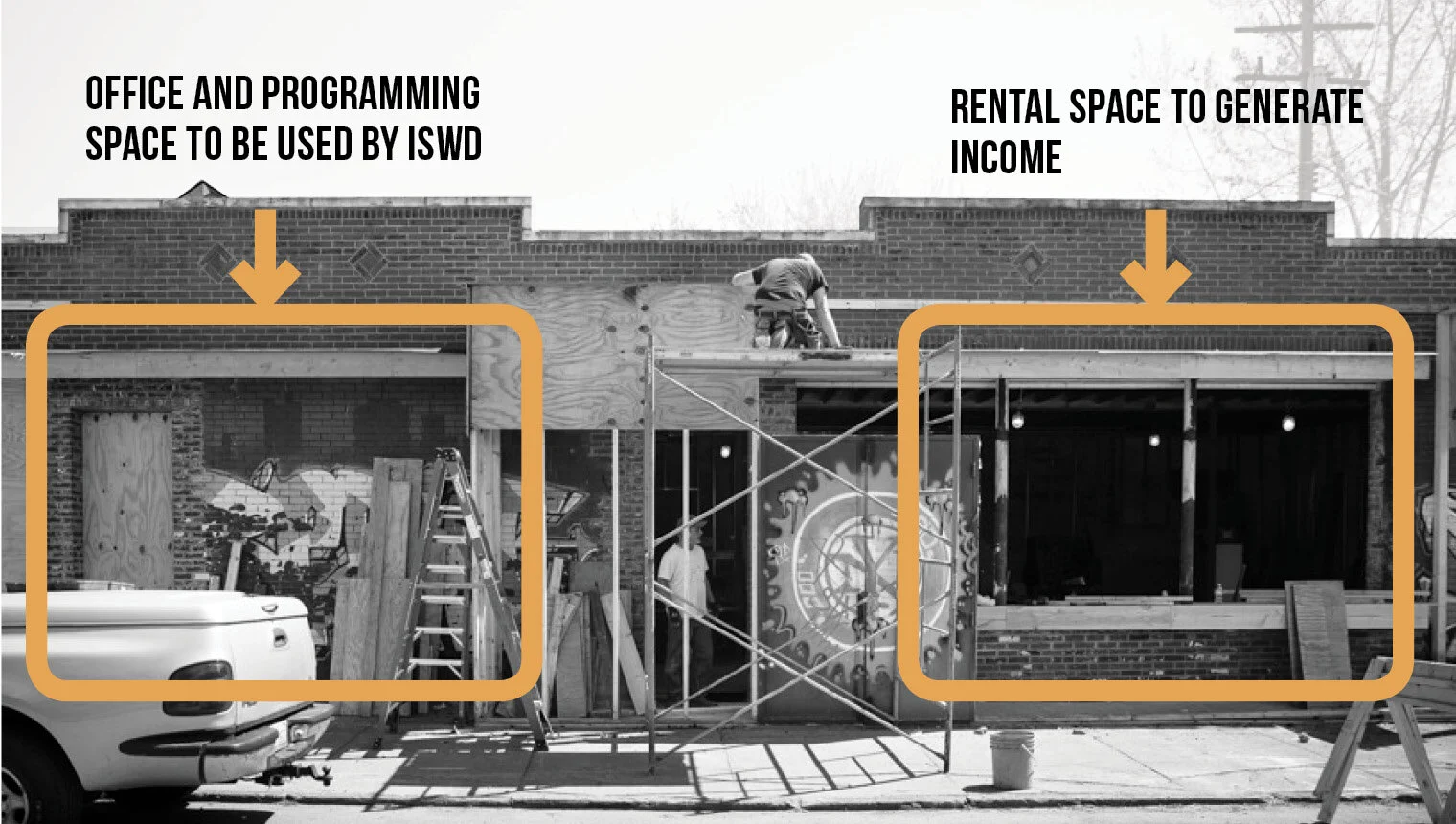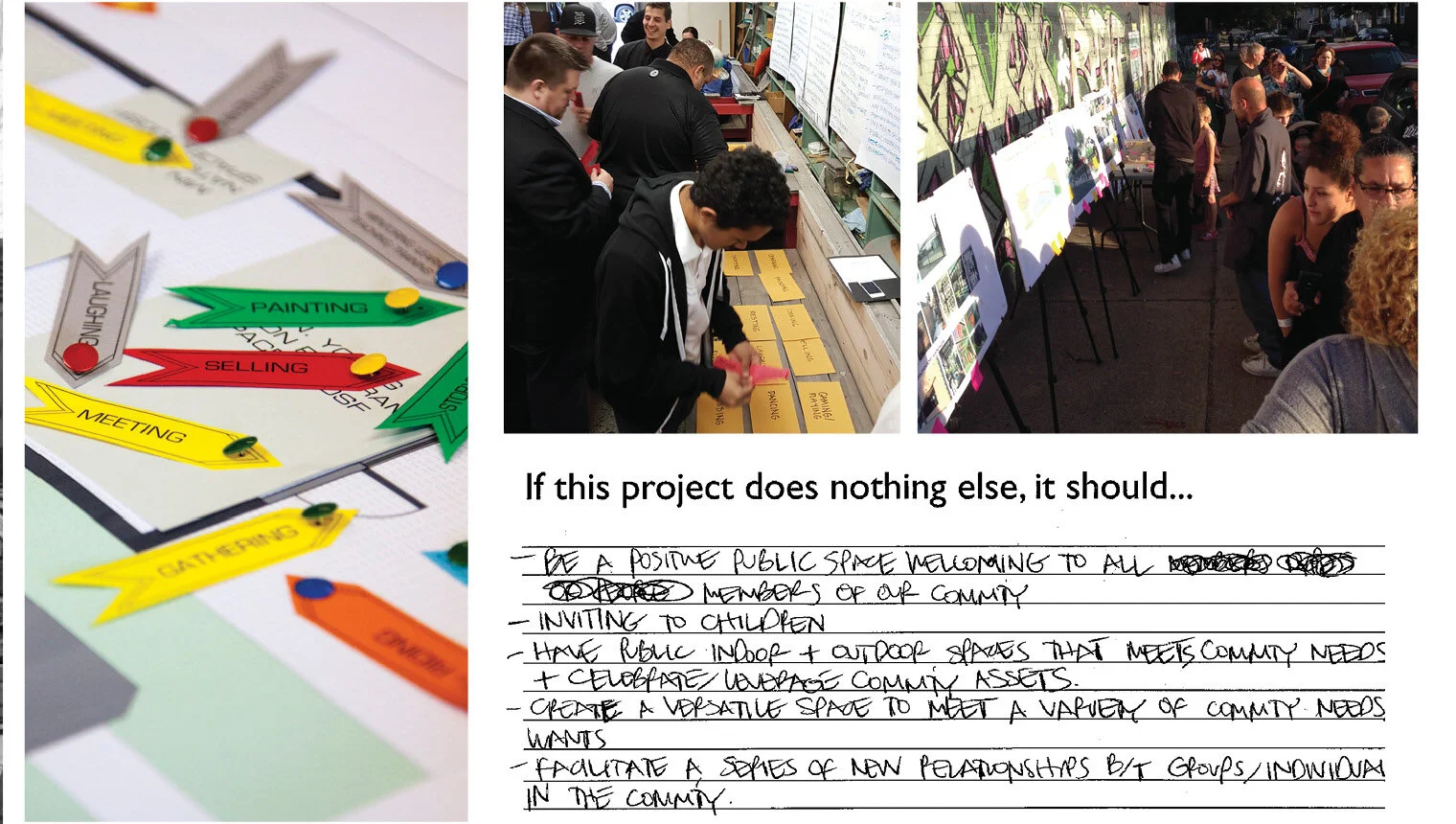
About this tool
The Detroit Collaborative Design Center (DCDC) at the University of Detroit Mercy School of Architecture partnered with Inside Southwest Detroit (ISWD) to design this engagement tool that is both a story-telling device for the Avis and Elsmere project and communicates the values and strategies that drive participatory design and community organizing work. The following webpage brings to life all the layers of a community-engaged design project: from pedagogy, to values, to community voices, and tactics. Though the overall outline describes principles, then strategies, and tactics, there are also anecdotes from on-the-ground experience along the way.
Though this webpage is intended to be a field guide, outlining the foundational aspects of community-engaged design, it is also meant to offer a narrative perspective of the Avis and Elsmere development and to feature the perspectives of key community stakeholders who were a part of the design process.
About Avis & Elsmere
ISWD promotes youth and community development through cultural and place-based initiatives in Southwest Detroit. Starting in 1999 with The Alley Project (TAP), a transformation of vacant lots and alley to a graffiti art gallery and gathering space, ISWD continues to support programming ranging from media and storytelling to youth programming via Young Nation.
Avis and Elsmere entails the re-design of a small commercial building that houses the program space of ISWD and includes space for neighborhood businesses. The design extends to a vacant lot across the street, which will feature a skating plaza and performance space as well as seating areas. The community design process led by DCDC included a series of workshops with a key group of neighborhood stakeholders and informed schematic design. Et al. Collaborative, the Architect of Record for this project, was an active partner throughout the engagement process, and brought the design to fruition after the community, DCDC, and Et al. Collaborative completed schematic design.
Engagement Principles
What values guide the work?

For ISWD, participatory design is a set of values
“Participatory design is not just about planning a building, it’s a way of being in matters that are big and small...[The practice of participatory design] is actually a living out of a set of values, it’s not just a formal process or a prescription...it’s an acting out of a set of values and for that reason it has infinite application.” - Erik

Principle #1: Engagement is building relationships
Relationships include evolving and ongoing connections with neighbors, residents and partners. Importantly, community engagement is not transactional. For ISWD, human capital is valued equally to economic capital. Existing community relationships were leveraged to bring more diverse voices to the table.
“You need to have relationships or at least some foundation of relationships to facilitate quality engagement, but at the same time, a good engagement process can help to facilitate the relationship itself. They really feed into each other...It’s reciprocal...You need one to have the other...And they build on one another.” - Erik
Residents and Artists Working For Their Community
“It’s our community, we live here. I’ve been here my whole life...we care about the place where we might want our kids to grow up...These are the things that hit home to us so we take those values very seriously.” - Freddy

Engagement is Best Supported by Organic, Grassroots Community Relationships
“There’s other neighborhood projects we’ve been able to be involved in just through hyper-local connections and valuing that input. So me being a person who’s been working with the neighbors for a long time...if that level of trust wasn’t there we wouldn’t be able to pick up the phone and call our neighbors to say, ‘hey, what are some things that you need?’” - Nyasia

Elders Synthesize Cultural Legacies to Imagine Creative Futures through Design
“Let me say that the design fits the neighborhood. I’m 80 and I was in a very serious car accident, so I have some physical disabilities. And access to the building is very good, is very accessible...I’ve been a lifelong resident here. In fact, that was a place where in the 50s, we would go to buy our cancan slips.” - Mary

Principle #2: Create a dynamic exchange of information
Engagement is a two-way exchange that celebrates a range of expertise and invites diverse perspectives. Meaningful partnerships mean shared decision making. For Avis and Elsmere, both the architect & the community members learned through the process. Design expertise is necessary to keep the building standing, and local wisdom is necessary to guide the space’s identity. Participatory design flips the traditional hierarchy of decision making upside-down. The youth holds the pencil and the architect learns.
“In a participatory process [everyone] sits at the table + informs each other...The architect needs to learn some important things about the community...that allows [the community] to feel open and invited...An architect gets to really create some design education and deliver it in a small personalized setting...you’re giving them a language to communicate what their needs are while being creative.”
- Erik
Principle #3: Value local knowledge and lived experience
Neighbors are superheros! ISWD is driven by the perspective and talent of their community. Elders, youth, neighbors, and artists are central to their work. In turn, these voices were central to the design process.
“When people are allowed to show up fully as who they are [to the design process]...they get to be a superhero designer version of themselves...with the right amount of knowledge and information and an environment that’s healthy, inviting, accessible, and engaging, they are prophetic in their ability to design in a way that meets the needs of the community, inspires people, and is sustainable in the long term.” - Erik
An Avis Anecdote
The Importance of Holding Space for Creativity
“A lot of the times people aren’t asked these questions that happen at these tables. They’re not asked what they want, they’re not asked what they would like to see. Even just being able to use your imagination to think of this happening in your neighborhood, that’s something that doesn’t happen very often. Usually things are forced or taken away and then something else is bartered.” - Nyasia

Engagement Strategies
How do community engagement principles come to life?

Strategy #1: Define your community
Every community and project is different. A first step is determining who should be involved in the design process and who are key types of community members. In the case of ISWD, community included neighbors, elders, artists, and representatives from ISWD. The measure of success of a project is the frequency and depth of unlikely relationships that come about as a result of that work.
“Sometimes [community elders and youth] don’t wind up in the same spaces...creating opportunities for them to get together helps with the frequency of interactions, but the depth comes from facilitating good conversation...The reason that we look at [relationship building] as a central measure of success: it builds community...When people who don’t know each other meet and talk, dormant community assets are activated.” - Erik
Strategy #2: Develop a variety of strategies for a variety of people
“I think there’s an assumption that people will come to you...and if we waited for everybody to come to us we wouldn’t have those projects. We were literally on doorsteps everyday plus the day before plus the hour before just to make some of these happen because we valued the voices that needed to be at the table. Their opinions outweighed us bugging them.” - Nyasia
Strategy #3: Engage through multiple phases and feedback loops
It is important to integrate engagement in multiple phases of a project, not just during design, or any other phase. It is also critical to build in feedback loops so people see how their input impacts design. For Avis and Elsmere, these feedback loops included accessible, outdoor community events that encouraged neighbors who might not have heard of the project to come and see what is going on in their neighborhood. These events served to share about the progress of the entire design as well as sharing details of the design for neighbors to give input on.
“When you do have consistency and you’ve been able to structure or scaffold an environment for programming that’s healthy, people want to come and they want to be there. Whether there’s a lot of people or a little bit of people, they interact and engage with each other. What’s fantastic is when those engagements get to impact how the program grow, how they sustain, and how they continue.” - Erik
An Avis Anecdote
Community Feedback Highlighted in a Design Workshop
“This neighborhood has a lot of wrought iron. And I remember discussions about wrought iron [in the design workshops]...[The porch] has an accordion fold that you can open up...But what’s really cool about it is the reflection of the glass, is the way the sun hits. And then the image, there’s the wrought iron shadows coming in.” - Mary

Practices in Design
How are engagement practices incorporated into design?

Practice #1: Be clear about givens
There are real world constraints for any project. Being open and transparent about project needs will help frame the conversation, while still encouraging creative strategies and ideas. Having the boundary of givens allows for greater freedom of exploration in design.
“Being introduced to the language of givens and their role in a design process was an important moment for us. We would often talk about transparency or engagement, but the participatory design process laid out a method...learning about the process in a general way allowed us to be better at our practices and more intentional and expressive about our values.” - Erik
Practice #2: Set collective design intentions
Invite participants to set the intentions for the project that will drive design decision-making. One activity that helps define these goals starts with “If nothing else...” and generates project priorities. A priority in the Avis and Elsmere project was “bring people together.”
“ All of us have different opinions and different ideas, but they were able to take those ideas, those differences, and pull them together to create something that we all could have a part in. The building has multiple uses in a small container. This little container...and when you open the lid, it just flows.” - Mary
Practice #3: Use verbs to generate program and design ideas
Using verbs instead of nouns helps generate create space solutions. Verbs are how one imagines futures. While a table offers one solution, the verbs “gather” and “share” offers a range of possible solutions! For ISWD, a key verb that was highlighted in the process was “revolutionizing.” The design team continually reflected on this verb and how it could come alive in the design.
“Participatory design processes don’t start with nouns...they start with verbs: what would we like to be able to do in the space? That’s why the dynamic exchange of information at the table is so important because you have so many different folks and perspectives that can contribute to a design intervention that...helps the built environment perform that action.” - Erik
Practice #4: Invite participants to lead design discussion
As the design process proceeds, participants are well-positioned to lead the discussion - what is important to the space layout and why? What connections are important? What programs need to be included? In the image above, neighbors map verbs, sight lines, and activity zones on the project site.
“When it came to designing the building we wanted to make sure it gave off that vibe, when you walk in it felt good...versus being about ‘this has to be a certain height.’...My favorite memories of being in the building since it’s been renovated have been the Blackbook sessions. We would have a turnout of like 15 people...an older generation of artists and younger artists... all of us being in the same room being creative.”
- Freddy
An Avis Anecdote
Leading the Design Discussion as an Artist
“There has to be some integrity in the creative process. I think what’s important is to put your ego aside and to be in tune with what’s going on...and be observant. You’re going to learn a lot more that way. You always want to be inclusive so that people that live there enjoy it too. I like to learn and as long as I’m being inclusive & I’m getting feedback from people, I’m always learning.” - Freddy

Practice #5: Center local culture
Meaningfully integrating local culture brings projects to life! At Avis and Elsmere, the artwork is integrated into the building design and embodies a powerful history. The metal screen integrates local craft.
“The color palette is baked into the process; art and dance and freedom and expression is baked into the process...Even if we know what we’re doing when we’re doing it, it continues to surprise us over time.”
- Erik
Practice #6: Celebrate!
Celebrating the design process, outcomes and community contributions is important! Celebrations also offer an opportunity to invite more people and perspectives into the conversation. For Avis & Elsmere, having public events attracted passers-by and neighbors that otherwise would not have seen an event flyer.
“[Celebration] is what makes everything possible. Without it, it just wouldn’t exist. Because every day that [the project] exists is a celebration. I always say, the greatest thing about this community is the people...To celebrate one another’s culture & one another’s being, makes us understand one another better...And for me, that is what’s going to give us some peace, to know one another. And the importance of celebrating our culture, our visions, with the young people.” - Mary
Thank you!

Many thanks to all of the partners that have helped bring this book to fruition! Special thanks to Nyasia, Freddy, and Mary, and all community champions, whose time, commitment, and talent have, and will continue to, shape your neighborhood.
We are also grateful for the generous funding from the Kresge Foundation, for helping make this work possible.





















